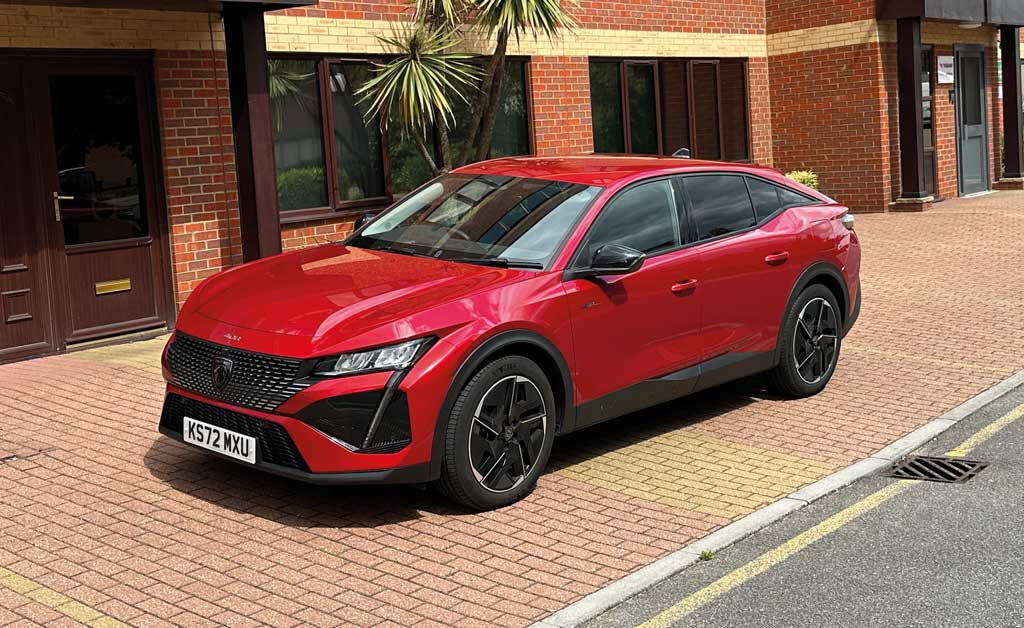
It’s been a few years since Peugeot has had a model in its range starting with a ‘4’. My first car was a 405, and so I reckon that I’m going to be a good judge on whether this latest 408 is as good as that was. I’m also a huge fan of big Peugeots, and the last to wear a ‘4’ badge was the 407 that was phased out in 2011 to make way for the 508, which was larger in every direction. In the intervening years, the Chinese market had a 408, which was effectively a booted 308, but here in Europe we’ve generally fallen out of love with non-premium saloons and so it wasn’t sold here.
But when Peugeot decided to spin off a sexier fastback bodystyle from the 308, the 408 was the obvious choice, indicating that it is a step up from the popular medium hatchback and estate. And doesn’t it look great, especially in the Elixir Red varnish paint, and thanks to the aggressive nose treatment and the fastback body. The only disappointment is that the back bumper is finished in black plastic, rather than being painted in the same colour as the body, but perhaps that’s so that it doesn’t get damaged when hauling luggage and all kinds of shopping in and out of the expansive 536-litre boot. Fold down the rear seats and that opens up to 1,611 litres and is actually slightly bigger than the plug-in hybrid 308 SW.
Connect the 408 to the mains and you’ve got 40 miles of pure electric power, which is ideal if you are simply darting around town. You can then do all local running around emissions free, and at a fraction of the cost of filling up at a petrol station, if you charge at home, and especially if you’re on an EV-friendly electricity tariff. For journeys further afield there’s a 40-litre petrol tank which should give you around 350 miles of range at a rate of 40mpg. A lighter right foot should yield you even more, especially if you make full use of the ‘B’ button on the eight-speed automatic transmission that boosts up the brake regeneration system, harnessing energy as you slow down. I find it a much more relaxing way of driving, as you rarely have to use the brakes.
Our car is finished in mid-range Allure Premium trim, with Allure the entry point to 408 ownership and GT the flagship. Our car features the most powerful plug-in hybrid drivetrain, with a total of 221bhp on tap thanks to a 178bhp 1.6-litre turbocharged PureTech petrol engine and 109bhp electric motor. When combined, there’s swift performance off the line, with the 0-62mph dash achieved in a hot-hatch rivalling 7.8 seconds. Peugeot claims that you can achieve as much as 269.5mpg when combining both petrol and electric power together, but as with all plug-in hybrids, you can take those kinds of figures with a heavy dose of sodium. It’s not that Peugeot is being disingenuous, it’s that the measuring system isn’t particularly realistic, and so silly figures are registered. It would be lovely if EU governors asked manufacturers to test their cars based on an empty battery pack as well, as that would be a fairer representation of what can be achieved as a worst-case scenario. It’s almost like the EU is setting up car manufacturers to fail and make them look like all of the figures were created by engineers in white coats with noses like Pinocchio.
If like me, you have the driver’s seat in the furthest back position, there’s still a generous amount of space in the rear for another tall occupant to sit, thanks to lots of leg and knee space. And even though the 408 features a slippery silhouette, head room is pretty good, too. The stance is that of a fastback crossover, with an elevated appearance that looks pretty imposing. Since it arrived, so many passers by have commented on its looks – probably more than any other car that I have run, aside from my much missed Kia Stinger. In many ways the 408 and the Stinger are similar, albeit different in size. The good news is that I’m as excited to drive my 408 as when I first got the keys, and that bodes well for the next six months.
Mileage 4,521
Date arrived 27th July 2023
Economy (combined) 269.5mpg
Economy (On test) 40.3mpg
© Motorworld Media 2023
Registered Office: 4 Capricorn Centre, Cranes Farm Road, Basildon, Essex. SS14 3JJ
Company Number: 8818356
Website designed by Steve Dawson